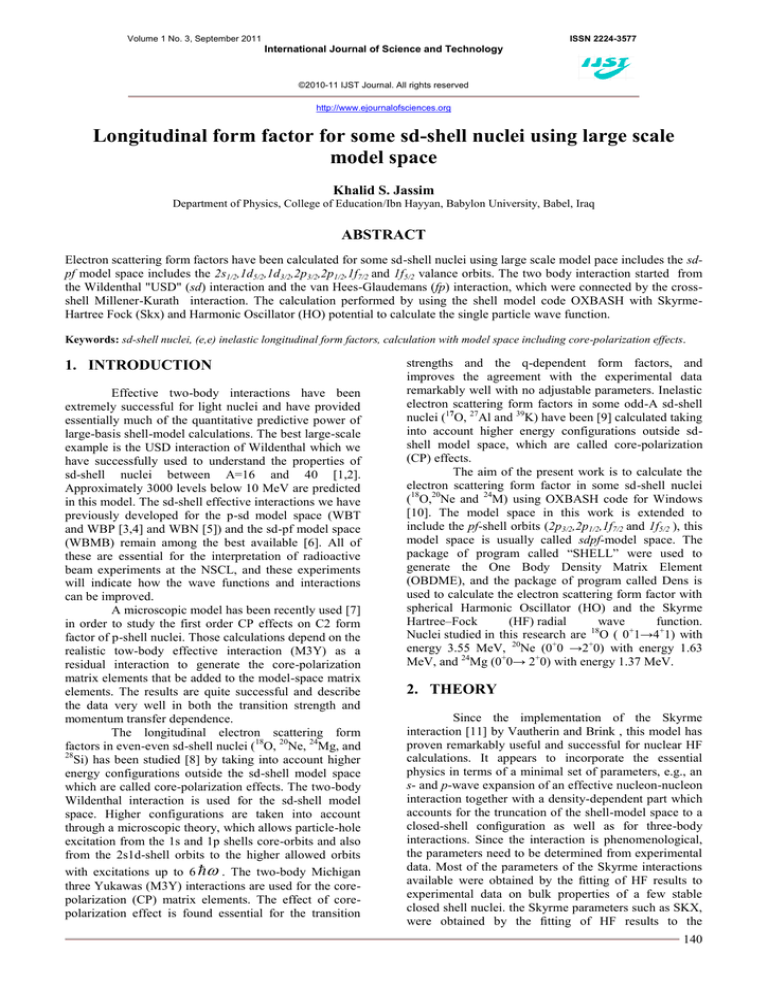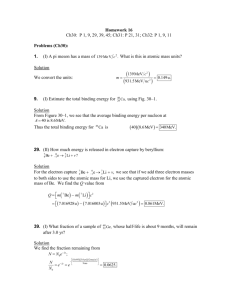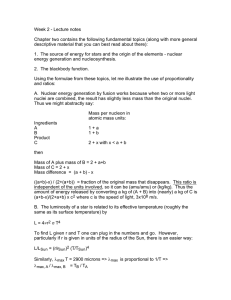
Volume 1 No. 3, September 2011
ISSN 2224-3577
International Journal of Science and Technology
©2010-11 IJST Journal. All rights reserved
http://www.ejournalofsciences.org
Longitudinal form factor for some sd-shell nuclei using large scale
model space
Khalid S. Jassim
Department of Physics, College of Education/Ibn Hayyan, Babylon University, Babel, Iraq
ABSTRACT
Electron scattering form factors have been calculated for some sd-shell nuclei using large scale model pace includes the sdpf model space includes the 2s1/2,1d5/2,1d3/2,2p3/2,2p1/2,1f7/2 and 1f5/2 valance orbits. The two body interaction started from
the Wildenthal "USD" (sd) interaction and the van Hees-Glaudemans (fp) interaction, which were connected by the crossshell Millener-Kurath interaction. The calculation performed by using the shell model code OXBASH with SkyrmeHartree Fock (Skx) and Harmonic Oscillator (HO) potential to calculate the single particle wave function.
Keywords: sd-shell nuclei, (e,e) inelastic longitudinal form factors, calculation with model space including core-polarization effects.
1. INTRODUCTION
Effective two-body interactions have been
extremely successful for light nuclei and have provided
essentially much of the quantitative predictive power of
large-basis shell-model calculations. The best large-scale
example is the USD interaction of Wildenthal which we
have successfully used to understand the properties of
sd-shell nuclei between A=16 and 40 [1,2].
Approximately 3000 levels below 10 MeV are predicted
in this model. The sd-shell effective interactions we have
previously developed for the p-sd model space (WBT
and WBP [3,4] and WBN [5]) and the sd-pf model space
(WBMB) remain among the best available [6]. All of
these are essential for the interpretation of radioactive
beam experiments at the NSCL, and these experiments
will indicate how the wave functions and interactions
can be improved.
A microscopic model has been recently used [7]
in order to study the first order CP effects on C2 form
factor of p-shell nuclei. Those calculations depend on the
realistic tow-body effective interaction (M3Y) as a
residual interaction to generate the core-polarization
matrix elements that be added to the model-space matrix
elements. The results are quite successful and describe
the data very well in both the transition strength and
momentum transfer dependence.
The longitudinal electron scattering form
factors in even-even sd-shell nuclei (18O, 20Ne, 24Mg, and
28
Si) has been studied [8] by taking into account higher
energy configurations outside the sd-shell model space
which are called core-polarization effects. The two-body
Wildenthal interaction is used for the sd-shell model
space. Higher configurations are taken into account
through a microscopic theory, which allows particle-hole
excitation from the 1s and 1p shells core-orbits and also
from the 2s1d-shell orbits to the higher allowed orbits
with excitations up to 6 . The two-body Michigan
three Yukawas (M3Y) interactions are used for the corepolarization (CP) matrix elements. The effect of corepolarization effect is found essential for the transition
strengths and the q-dependent form factors, and
improves the agreement with the experimental data
remarkably well with no adjustable parameters. Inelastic
electron scattering form factors in some odd-A sd-shell
nuclei (17O, 27Al and 39K) have been [9] calculated taking
into account higher energy configurations outside sdshell model space, which are called core-polarization
(CP) effects.
The aim of the present work is to calculate the
electron scattering form factor in some sd-shell nuclei
(18O,20Ne and 24M) using OXBASH code for Windows
[10]. The model space in this work is extended to
include the pf-shell orbits (2p3/2,2p1/2,1f7/2 and 1f5/2 ), this
model space is usually called sdpf-model space. The
package of program called “SHELL” were used to
generate the One Body Density Matrix Element
(OBDME), and the package of program called Dens is
used to calculate the electron scattering form factor with
spherical Harmonic Oscillator (HO) and the Skyrme
Hartree–Fock
(HF) radial
wave
function.
Nuclei studied in this research are 18O ( 0+1→4+1) with
energy 3.55 MeV, 20Ne (0+0 →2+0) with energy 1.63
MeV, and 24Mg (0+0→ 2+0) with energy 1.37 MeV.
2. THEORY
Since the implementation of the Skyrme
interaction [11] by Vautherin and Brink , this model has
proven remarkably useful and successful for nuclear HF
calculations. It appears to incorporate the essential
physics in terms of a minimal set of parameters, e.g., an
s- and p-wave expansion of an effective nucleon-nucleon
interaction together with a density-dependent part which
accounts for the truncation of the shell-model space to a
closed-shell configuration as well as for three-body
interactions. Since the interaction is phenomenological,
the parameters need to be determined from experimental
data. Most of the parameters of the Skyrme interactions
available were obtained by the fitting of HF results to
experimental data on bulk properties of a few stable
closed shell nuclei. the Skyrme parameters such as SKX,
were obtained by the fitting of HF results to the
140
Volume 1 No. 3, September 2011
ISSN 2224-3577
International Journal of Science and Technology
©2010-11 IJST Journal. All rights reserved
http://www.ejournalofsciences.org
experimental data on the bulk properties of nuclei
ranging from the ß-stable nuclei to those near the proton
and/or neutron drip lines.
The sd-pf Hamiltonian depends upon four types
of TBME [12]:
Preedom- Wildenthal (PW)
interaction
the Van Hees-Glaudemans
(VHG) interaction
Millener-Kurath (MK)
interaction
All nuclear structure information is contained in
the longitudinal form factor FL (q) , representing the
scattering from the nuclear charge density, and the
transverse form factor FT (q) , representing the
scattering from the nuclear current density. These form
factors are given by the well-known multiple
decomposition[13]:
FJ2 (q)
2
2
2
4
1
J f TˆJL (q) J i F (q) F (q) (1)
2
c
.
m
f
.
s
Z (2 J i 1) J 0
The many body reduced matrix elements of the
electron scattering operator Tˆ consist of two parts, one
is for the "Model space" matrix elements, and the other
is for the "Core-polarization" matrix elements [14]
f TˆJ ( z ,q) i f Tˆ ( z ,q) i
3. RESULT AND DISCUSSION
In the present work, the electron scattering form
factor with core-polarization effects are included through
microscopic theory to discuss J+T = 2+0 and 4+1 states
for the light sd-shell nuclei 18O, 20N, and 24Mg. Corepolarization effects are taken into account through the
first-order perturbation theory, which allows particlehole and two particles-two holes excitation respectively,
from the 1s and 1p shell core orbits to the higher allowed
orbits with 2 excitation. The one-body density
matrix elements (OBDM) values for sd-shell nuclei
under consideration in the present work are taken from
ref. [15]. The many-particle matrix element that includes
both the model space and the core-polarization effects
are calculated according to equation (3). Finally, the
nuclear form factor can be obtained from equations (1).
The 18O nucleus has been the subject of extensive
theoretical and experimental studied. They have been
received much attention in last decade. The 18O system
contains two neutrons in addition to 16O core distribution
in sdpf-shell. The electron excites the nucleus from the
ground state (JiTi= 0+1) to the state (JfTf =4+1) with
excitation energy of 3.55 MeV. The single-particle radial
wave functions are those of HO potential with size
parameter brms=1.879 0.023 fm [16]. Figure (1) shows
the relation between the longitudinal C4 form factor as a
.
(3)
CP
The model space (MS) matrix elements are
expressed as the sum of the product of the one-body
density matrix elements (OBDM) times the singleparticle matrix elements, which is given by:
J f TˆJ ( z , q) J i
ms
e(t z ) dr r 2 jJ (qr ) Jmst (i, f , r )
0
z
(4)
(4)
Where ms (i, f , r ) is the charge density of model space
J tz
which is given as:
ms (i, f , r ) OBDM J t (i, f , a, b) ja YJ jb Rn l (r ) Rnl (r )
z
J tz
(5)
a ,b
and the core-polarization matrix elements is given as:
.
f Tˆ ( z , q) i
e(t z ) dr r 2 jJ (qr ) cpJ tz (i, f , r ) (6)
0
cp
where
The nucleon finite size (fs) form factor is
Ffs(q)=exp(-o.43q2/4) and
F cm(q) = exp
(q2b2/4a) is the correction for the lack of translation
invariance in the shell model.
MS
f Tˆ ( z ,q) i
cp (i, f , r ) is
J tz
the core-polarization transition
density which is depends upon the model which is used
to calculate the core-polarization effect.
function of momentum transfers, where the dashed curve
represents the results of the form factor with sdpf wave
function with Core-polarization effects. The upper panel
(a) represents the form factor results that calculated with
the HO potential for the radial part of the single particle
matrix elements, while the lower panel (b) represents
those of the Skyrme-Hartree Fock (Skx) interaction. The
experimental data are taken from Ref. [17]. The results
are closer to the experimental data. The form factors at
the low momentum transfer (0.8 -1.5) fm-1 with the HO
potential give a good agreement with the experimental
data, comparing with Skx potential.
From Figure (1-b), one can see that the
theoretical results with Skx interaction are in excellent
agreement with experimental data in the momentum
transfer range between (1.5-2.2) fm-1. The calculated
B(C2) values with the inclusion of CP effects is (2.34
102) e2 fm4, in comparison with the measured value
(9.04± 0.9 102 e2.fm4 [18]).
20
Ne is consider as the 16O core and four
nucleons outside the core distribution over
2s1/2,1d5/2,1d3/2,2p3/2,2p1/2,1f7/2 and 1f5/2 shell space. The
nucleus is excited from the ground state (0+0) by the
incident electron to the state (JfTf= 2+ 0) with excitation
energy of 1.63 MeV. The size parameter of the harmonic
oscillator (HO) is equal to brms = 1.869 [15]. In Figure
(2), the calculated results of the sdpf-shell model space
141
Volume 1 No. 3, September 2011
ISSN 2224-3577
International Journal of Science and Technology
©2010-11 IJST Journal. All rights reserved
http://www.ejournalofsciences.org
(as the dashed curve) with including the CP effects are
compared with experimental data [19]. A good fit the
20Ne data is obtainable with the HO radial wave function
in the calculated second diffraction minimum at the high
momentum transfer region q ≥ 1.5 fm-1.
The ground state of 24Mg is of 0+0 and can be
described by a four proton and four hole in the sdpf orbits
outside the 16O inert core. The form factor for the C2
transition to the 0+2 state at 1.37 MeV, is displayed in
figure 3, calculated with sdpf-shell model wave functions
with Core-polarization effect. The upper panel (a)
represents the calculation with the HO potential for the
single particle state with size parameter brms=1.813fm
[15]. The lower panel represents the calculations
with the Skx interaction with Parameters (α=0.5 and
χ=0.73). When the form factor is calculated with HO
potential , as shown in the upper panel of figure 3, the
results are an excellent agreement with the data from Ref.
[20]for the first maximum for the region between (0.6 –
1.7)fm-1, and overestimate the data beyond that. At the
lower panel of figure 3, we notice that the theoretical
results gives a good agreement for the second diffraction
minimum for the momentum transfer q ≥ 1.7 fm-1. This
lead to that the Skx interaction is successful to described
the experimental data at the high momentum transfer.
Figure 2. The isoscalar electron scattering form factors
for the 2+0 (1.63 MeV) state in 20Ne. The dashed curve represent
the calculation with sdpf-model space. The upper panel
represents the form factors that calculated with HO potential for
radial part of the single-particle matrix elements, while the lower
panel represents those of the Skx interaction. The data are taken
from Ref. [19]
Figure 1. The isovector electron scattering form factors for the
4+1 (3.55 MeV) state in 18O. The solid curve represent the
calculation with sdpf model space. The upper panel represents
the form factors that calculated with HO potential for radial part
of the single-particle matrix elements, while the lower panel
represents those of the Skx interaction. The data are taken from
Ref. [20]
Figure 3. The isoscalar electron scattering form factors for
the 2+0 (1.37 MeV) state in 24Mg. The dashed curve
142
Volume 1 No. 3, September 2011
ISSN 2224-3577
International Journal of Science and Technology
©2010-11 IJST Journal. All rights reserved
http://www.ejournalofsciences.org
represent the calculation with sdpf-model space. The
upper panel represents the form factors that calculated
with HO potential for radial part of the single-particle
matrix elements, while the lower panel represents those of
the Skx interaction. The data are taken from Ref. [20]
[9]
K. S. Jassim, The second Scientific conference by
college of education / University of Babylon /
vol. (3) / Pages (125-135) / March 2008.
[10]
Oxbash for Windows, B. A. Brown, A.
Etchegoyen, N. S. Godwin, W. D. M. Rae, W. A.
Richter, W. E. Ormand, E. K. Warburton, J. S.
Winfield, L. Zaho, and C. H. Zimmerman, MSUNSCL, report number 1289 (2004).
[11]
Vautherin and D. M. Brink, Phys. Rev. C 5, 626
(1972).
[12]
B.A. Brown, the Nuclear Shell Model Towards
the drip line, East Lansing, Michigan (2002)
[13]
William, D. T. Donnelly and Sick, I. (1984),
Review-Mod. Physics. 56, 461.
[14]
Radhi, R. A. Bouchebak, A. (2003), Nuclear
Physics, A716, 87.
ACKNOWLEDGMENT
My express thank to Professor B A Brown of National
Superconducting Cyclotron Laboratory, Michigan State
University for providing me the computer code OXBASH.
REFERENCES
[1]
B. A. Brown and B. H. Wildenthal, Ann. Rev.
Nucl. Part . Sci. 38, 28(1988).
[2]
B. T. Neyer, D. L. Clark, J. S. Dunham, W. A.
Seal, J. L. Thornton, R. T. Westerretlt, S. S.
Hanna, B. A. Brown and B. H. Wildenthal, Phys.
Rev. C39,890 (1987).
[3]
F. K. Warbutron and B. A. Brown, Phys. Rev.
c46,923 (1992)
[15]
Brown, B. A. Radhi, R. and Wildenthal, B. H
Physics Report, (1983) 101,313.
[4]
H. Esbensen, B. A. Brown and H. Sagawa, Phys.
Revc51,1247 (1995).
[16]
[5]
E. K. Warbutorn, I. S. Towner, and B. A.
Brown,Phys. Rev. C49,824 (1994).
[6]
B. A. Brown, In: The structure of light nuclei,
International Scholl of Heavy- Ion Physics, 4th
course: Exotic Nuclei, (Erice, may 11-20,1997),
edited by R. A. Brogilaad P.G. Hansen (world
Scientific, 1998), P.1.
Manley, D. M. Millener, D. J. Berman, B. L.
Bertozzi, W. Buti, T. N. Finn, J. M. Hersman, F.
W. Hyde-Wright, C.E. Hynes, M. V. Kelly,
J.JKoVash, .M. A. Kowalski, S. Lourie, R. W.
Murdock, B. Norum, B. E. Pngh, B. and
Sargent, C .P. (1990), Physics Review, C41, 448.
[17]
Mc Grory and B. H. Wildenthal, Phys. Rev.
C7,974 (1973).
[18]
Engenland, Nuclear Physics, (1965), 72, 68.
[19]
Horikawa, Y.Torizuka, Y. Nakada, A.
Mitsunobu, S. Kojima, Y. (1971), Physics. Letter,
36B, 9.
[20]
Li, G. C. Yearian, M.R. and Sick, I.
Physics Review, (1974), C9, 5, 1861.
[7]
Radhi, Hamoudi, A. K. and Jassim, K. S.
(2007), Indian Journal of Physics, 81,7, 683-695.
[8]
K. S. Jassim, Journal of Babylon University/ pure
and applied Science, no. 3, vol. 15 (2009)
(1974),
143





